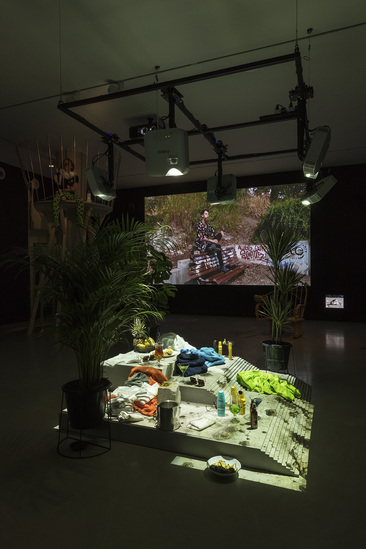-
From Current Issue
-
- Editor’s Letter Fire in the Heart
- Reviews I Gusti Ayu Kadek Murniasih
- Reviews 11th Seoul Mediacity Biennale: “One Escape at a Time”
- Dispatch Networked China
- One on One Monira Al Qadiri on Yukio Mishima
- Essays The rise of independent art spaces in pandemic-era Shanghai
- Features Tuan Andrew Nguyen
- Table of Contents
- Web Exclusives
- Archive
- Subscribe

R
E
V N
E
X
T
Installation view of TARO IZUMI’s “My Eyes Are Not in the Centre” at White Rainbow, London, 2018. All photos taken by Damian Griffiths; copyright Taro Izumi; courtesy White Rainbow, London and Take Ninagawa, Tokyo.
All visitors to Taro Izumi’s exhibition, “My Eyes Are Not in the Centre,” at London’s White Rainbow gallery, were monitored closely. Instead of hidden security cameras, however, it was a performer in a clown costume, perched on a watchtower installed in one corner of the gallery, who kept a vigilant eye over guests as they made their way around Izumi’s videos, installations and fragmented soundscape. With a wooden prosthetic arm gripping a handheld video camera, the clown’s surveilling presence effectively set up a hyper-self-consciousness in viewers.
The performance, Sphinx (all works 2018), was but one part of a deliberately over-stimulating exhibition. In his shows, Izumi typically aims to disorient the senses by layering an array of media within one open space. At White Rainbow, three mixed-media installations, Spring Is Between Winter and Summer, Sleeping Is Between Spring and Early Summer; Muscat Juice and Mud Mixed and Fucked, and the Earth Was Jealous; and ½ Poetry: Night bombarded viewers with competing sounds, a total of five simultaneously playing videos and lurid, illuminated objects. Allowing these components to clash and collide, Izumi creates a microcosmic reflection of the digital realm, wherein there is an immense quantity of contradictory information that in turn spurs the dissociation from what it is we are actually seeing.
Nevertheless, coherence could be found within this complex arrangement of works. Geological motifs and human interaction with the natural world were prominent themes that offered a point of entry into Izumi’s theater of the absurd. In Muscat Juice and Mud Mixed and Fucked, and the Earth Was Jealous, a woman happily masticates a rock. As the rock rolls in her mouth and her smile widens, the viewer’s discomfort grows. The pre-digested rock is pictured on a nearby screen reminiscent of a memorial, suggesting that Izumi is nostalgic for a connection with earth. Spring Is Between Winter and Summer, Sleeping Is Between Spring and Early Summer, a desolate, floor-based mise-en-scène accompanied by three videos, is similarly wistful. Laid out under projections of a pockmarked concrete surface is the detritus from a summer day: plates of exotic fruits degrade, sun-cream bottles and towels are strewn, and tropical cocktails putrefy. The triptych of videos give insight into what unfolded—people lounged in swimwear, cocktails were shaken and a large rock was manically chiseled away into an ice bucket. In the nearby ½ Poetry: Night, glowing, neon-hued, heavy-duty cleaning products are apotheosized seemingly for their artifice and ability to remove the dirt of the picnic scene. Izumi points to our nonsensical and temperamental relationship with the natural world: we desire it and its abundance, while seeking to eliminate and master it.
Elsewhere in the show, Izumi probed the veil that separates virtual from material. Five of the works, displayed across White Rainbow’s walled-off back room, attic and office, were only accessible via the camera mounted on the prosthetic arm of the performer. Upon request, the clown scurried away to film the installations, returning with a Vimeo link and password, with which users could then view their unique footage. The video focuses on Petitka (The Computer Screen), a large clay tablet with multiple thumbprints, in which sprigs of red feathers are planted. The camera then jolts along a wall, resting momentarily on a computer screen where a mountainscape is slowly animated before showing ½ Poetry: Noon (The Keyboard), colored footage projected on the computer’s keys.
The thinness of virtual experiences was particularly pronounced in the video ½ Poetry: Morning. The work depicts a computer screen playing a home-film of a baby gurgling at the camera, as well as footage of a stack of stodgy golden pancakes. Both the baby and pancakes have fingers poking them. Viewed through the clown’s recording, on visitors’ personal devices, the sensory affect of the sequences were abstracted and diluted through multiple screens. In this way, Izumi reaffirmed that physical presence and direct interactions with artworks are meaningful. “My Eyes Are Not in the Centre” prompted considerations of how our relationships with our surroundings, when mediated by technology, diminishes the potential of our responses.
Taro Izumi’s “My Eyes Are Not in the Centre” is on view at White Rainbow, London, until November 3, 2018.
To read more of ArtAsiaPacific’s articles, visit our Digital Library.
















